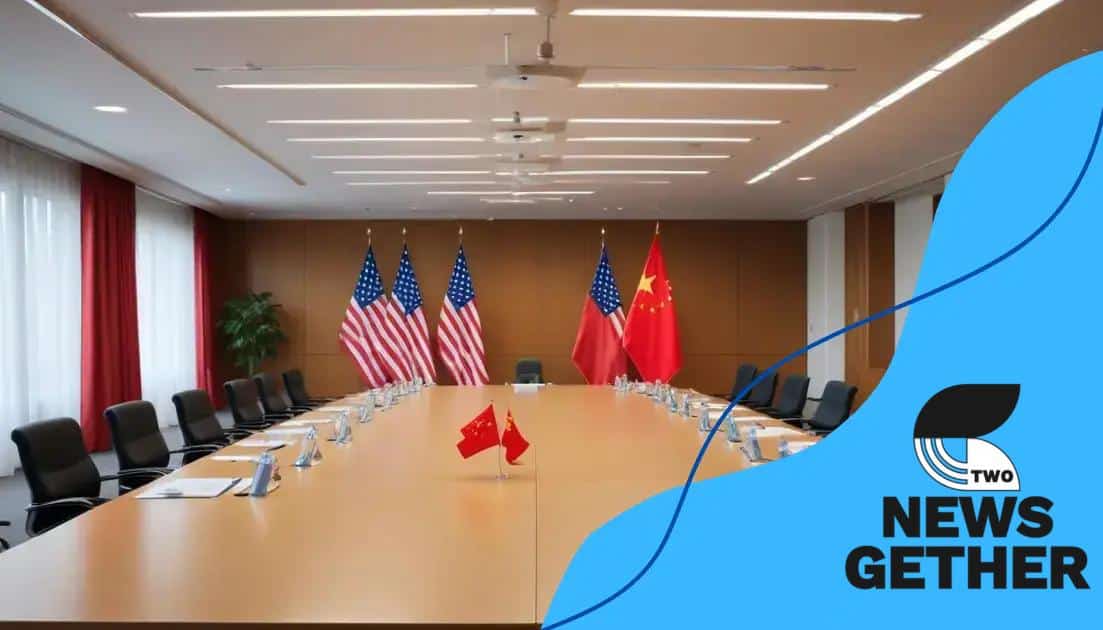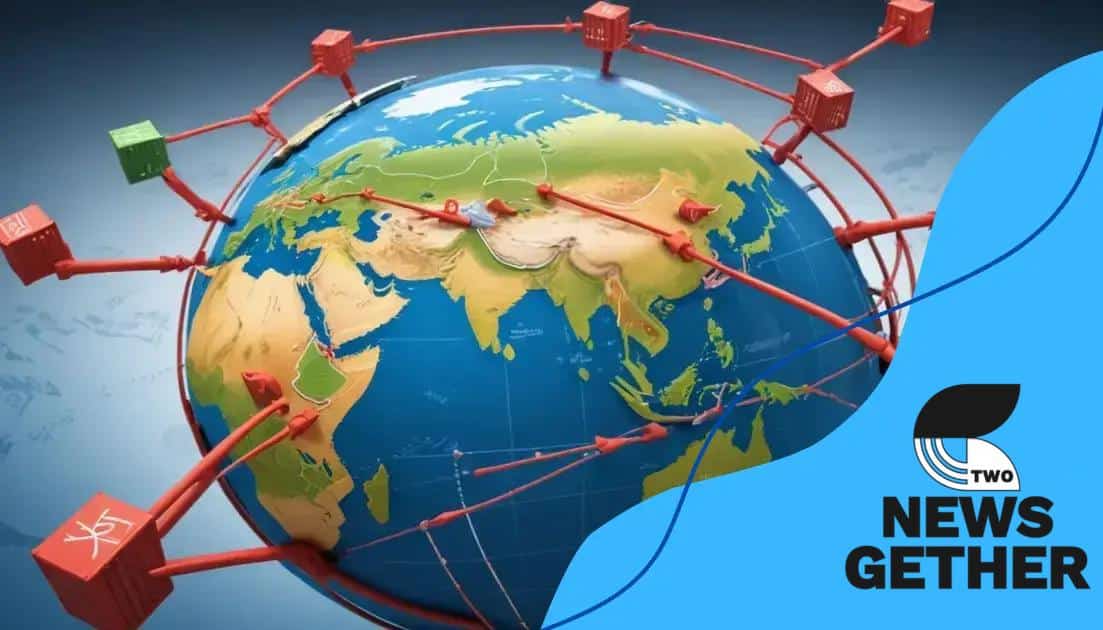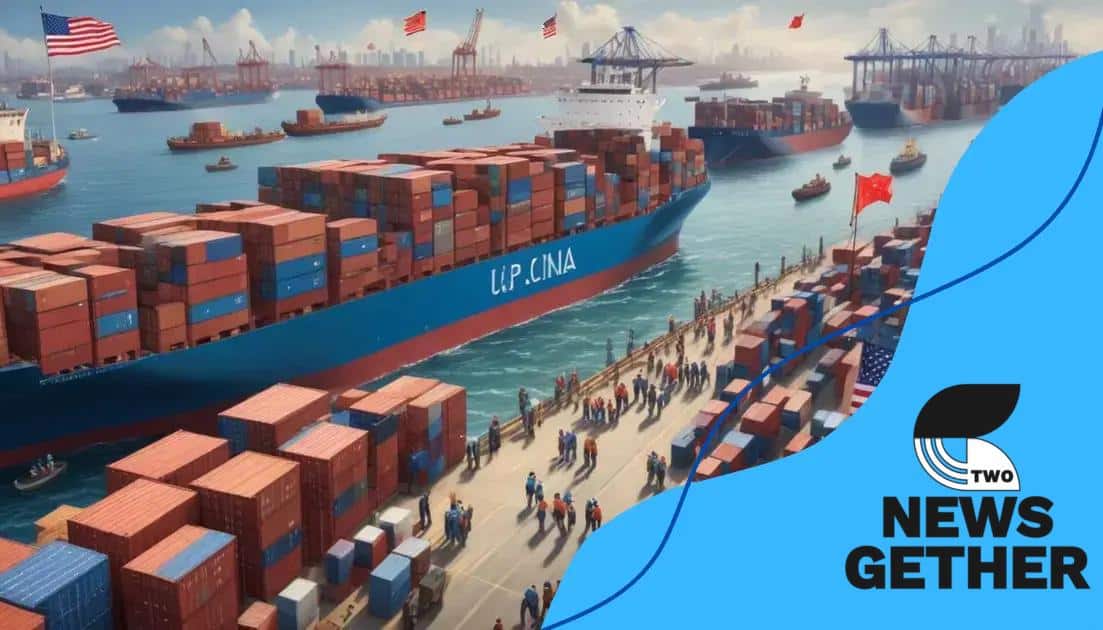US-China tariff negotiations Geneva: what’s at stake?

The US-China tariff negotiations are critical as they can lead to lower tariffs and improved trade relations or result in increased tensions and higher costs for consumers, significantly impacting global trade policies.
US-China tariff negotiations Geneva are drawing attention as significant shifts in trade policies loom. With both nations at a crossroads, have you considered how this might affect global markets?
Overview of US-China trade relations
The US-China trade relations have been a crucial part of the global economy for decades. Understanding their impact can help you see just how intertwined these two economies really are.
Trade Volume and Economic Significance
Both the United States and China are among the largest economies in the world. The trade volume between them reaches hundreds of billions annually, affecting markets globally. This interdependence means that policies in either country can ripple through international trade.
Key Products in Trade
The trade relationship encompasses various sectors. Here are some vital products involved:
- Electronics, including smartphones and computers
- Agricultural products, such as soybeans and pork
- Machinery and equipment
- Textiles and apparel
Each of these items plays a significant role in the economies of both nations. For instance, American farmers rely heavily on Chinese demand for their crops, while China depends on US technology for its manufacturing processes.
The dynamics of tariffs also affect US-China relations. The introduction of tariffs has led to fluctuating trade agreements and negotiations, creating uncertainty in the market. As both sides negotiate, the stakes become higher, influencing consumer prices and supply chains.
Recent Developments
In the past few years, we’ve seen increased confrontations regarding trade policies. The trade war marked a significant shift, as tariffs were increased and new restrictions were imposed. These changes not only affected businesses within both nations but also had global repercussions.
To navigate this evolving landscape, it’s essential to stay informed about the latest news and negotiations happening between the two countries. If both sides can reach a compromise, it could lead to a more stable trading environment.
By understanding the framework of US-China trade relations, stakeholders can make informed decisions that align with their interests. This relationship continues to evolve, and observing these changes can provide insights into future economic trends.
Key issues in Geneva negotiations
The Geneva negotiations between the US and China focus on several critical issues that impact their trade relationship. This dialogue aims to address tensions and find common ground.
Tariffs and Trade Barriers
One of the main points of contention is tariffs. Both countries have imposed various tariffs on each other’s goods, altering prices and availability. Finding a way to reduce these tariffs is essential for restoring trust and encouraging trade.
Intellectual Property Rights
Another significant issue is intellectual property rights. The US has accused China of inadequate protections for American innovations. Addressing these concerns could improve business partnerships and promote fair competition.
- Strengthening patent protections
- Preventing forced technology transfer
- Enhancing cybersecurity measures
- Encouraging transparency in trade practices
Addressing these topics ensures that both nations can innovate without fear of theft or exploitation.
Meanwhile, market access remains a pressing issue. Many American firms face challenges entering Chinese markets due to regulations and restrictions. Broadening access could benefit both economies, leading to increased sales and job creation.
Environmental and Labor Standards
Furthermore, environmental concerns and labor standards are increasingly relevant in these negotiations. As global awareness of climate change rises, both countries must ensure their trade practices also foster sustainability. Establishing clear guidelines can help balance economic growth with environmental responsibility.
Additionally, labor conditions in both nations often come under scrutiny. Fair labor practices must be prioritized, as they reflect on each country’s commitment to ethical trade.
With these key issues on the table, the potential outcomes of the US-China Geneva negotiations will significantly influence global trade patterns and economic stability moving forward.
Impact on global trade policies

The impact on global trade policies due to US-China negotiations is profound. As these two economic giants engage in discussions, the effects can be felt worldwide.
Shifts in Trade Agreements
One major area of concern is how changes in US-China relations will reshape existing trade agreements. As tariffs fluctuate, countries involved in trade with either the US or China might need to adjust their own policies.
Influence on Emerging Markets
Emerging markets are particularly affected by these negotiations. Countries that rely heavily on exports to the US or China face uncertainties. A favorable agreement could open up new opportunities, while a breakdown in talks may lead to tightened restrictions.
- Increased tariffs can hurt exports
- Improved access could boost local economies
- Changing regulations may invite foreign investment
- Balancing between US and Chinese markets becomes crucial
These shifts can create ripple effects, influencing local businesses and employment rates.
Innovation and Competition
Additionally, the outcome of these negotiations can drive innovation and competition. As countries adjust to new reality, they may need to find ways to enhance their products and services. This competition can lead to technological advancements and improved efficiencies.
The global stage is watching closely, as the US-China negotiations could redefine how countries approach trade issues. Nations might adopt new policies, inspired by the outcomes of these discussions. Whether it’s collaboration on standards or competition in tariffs, the implications are far-reaching.
Overall, the negotiations have the potential to change how nations interact in the global market. Understanding these dynamics helps companies and governments prepare for future challenges and opportunities.
Stakeholder perspectives
Understanding the stakeholder perspectives in the US-China negotiations is vital. Each group involved has different interests and priorities, which shape the discussions.
Government Officials
Government officials from both countries play a significant role. They aim to protect their nations’ economic interests while ensuring national security. For instance, US officials often focus on trade imbalances and protection of intellectual property. Meanwhile, Chinese officials may push for reduced tariffs and improved access to markets.
Businesses and Corporations
Businesses are equally important stakeholders. American companies want fair competition and access to the large Chinese market. They may express concerns about high tariffs that impact profits. On the other hand, Chinese companies seek favorable terms to support their growth and expansion in foreign markets.
- American firms desire lower tariffs
- Chinese enterprises want stable trade relations
- Both seek to protect intellectual property rights
- Cooperation can lead to shared technology
These competing needs often drive the negotiations, leading to a trade-off between different priorities.
Consumers and the Public
Consumers also have a stake in these discussions. They are affected by pricing changes resulting from tariffs. Higher tariffs can lead to increased costs for everyday goods, impacting family budgets. Therefore, public opinion often influences political leaders to consider the average citizen’s viewpoint during negotiations.
Finally, international organizations, like the World Trade Organization, monitor these negotiations closely. They are interested in upholding fair trade practices and ensuring that the rules of trade are respected. The perspectives of these stakeholders provide critical context for the challenges faced during the US-China negotiations.
As these discussions unfold, understanding the diverse interests of all parties involved will be crucial for effective policy-making and future trading conditions between the two countries.
Potential outcomes of the talks
The potential outcomes of the talks between the US and China could significantly shape the future of global trade. As both nations navigate their differences, multiple scenarios could unfold, affecting economies worldwide.
Increased Cooperation
One possible outcome is a framework for increased cooperation. If both countries reach an agreement, it may lead to lower tariffs and improved trade relations. This cooperation could help stabilize international markets and boost global economic growth.
Continued Tensions
On the other hand, if negotiations break down, we could see continued tensions. Such a scenario might result in higher tariffs and increased barriers to trade. This could negatively impact consumers, leading to higher prices for goods. It might also force companies to rethink their supply chains, affecting businesses around the world.
- Higher tariffs could lead to increased consumer prices
- Increased regulation could stifle innovation
- Global markets may react negatively to uncertainty
- Potential for further trade conflicts
The dynamics between these two powers play a crucial role in shaping international policies.
Impact on Emerging Markets
Emerging markets might feel the effects of these talks as well. Positive outcomes could enhance trade opportunities for these nations, while negative results might create challenges in accessing larger markets like the US and China.
Throughout this process, many stakeholders are watching closely, anxious about potential decisions that could affect job growth and economic stability in their own countries. Understanding these outcomes is essential for businesses and consumers alike, as the effects will likely resonate well beyond the two nations involved.
Future of tariffs and trade relations

The future of tariffs and trade relations between the US and China is uncertain yet crucial for the global economy. As negotiations continue, the direction they take will impact businesses, consumers, and international markets.
Possible Scenarios for Tariffs
In the coming years, one scenario could see a reduction in tariffs as both nations seek to foster better trade relationships. Lower tariffs might encourage more imports and exports, leading to greater economic activity. However, a different outcome could involve maintaining or increasing tariffs if negotiations falter. This would likely lead to higher prices for consumers and increased tension in global trade.
- Reduced tariffs could stimulate market growth
- Increased tariffs may provoke retaliatory measures
- Stability in tariffs can foster business planning
- Negotiated agreements could set precedents for future trade
These scenarios will shape how businesses strategize and prepare for the market.
Impact on Global Supply Chains
The structure of global supply chains will also be influenced by these changing trade relations. Companies may reassess their supply chains to manage costs effectively amid fluctuating tariffs. Businesses might seek to diversify their suppliers to avoid reliance on either nation, ensuring that disruption in one market does not impact overall operations.
Emerging markets may find new opportunities in this climate. If the US and China reduce tariffs, they could benefit from increased investment and trade. However, uncertainty can hold back growth if companies hesitate to invest.
In summary, the way forward for tariffs and trade relations will depend not only on negotiations but also on each country’s willingness to adapt to global market demands. The outcomes will certainly affect economic practices and shape the landscape of international trade for years to come.
FAQ – Frequently Asked Questions About US-China Tariff Negotiations
What are the potential outcomes of the US-China tariff negotiations?
The outcomes could range from reduced tariffs and improved trade relations to continued tensions resulting in higher tariffs.
How might tariffs impact consumers?
Increased tariffs can lead to higher prices for goods, while reduced tariffs might result in lower prices, benefiting consumers.
What is the significance of stakeholder perspectives in these negotiations?
Understanding stakeholder perspectives helps to grasp the competing interests and priorities that shape the discussions between the US and China.
Why should businesses monitor the developments of these negotiations?
Staying informed is crucial for businesses, as changes in tariffs and trade relations can significantly impact their strategies and supply chains.






